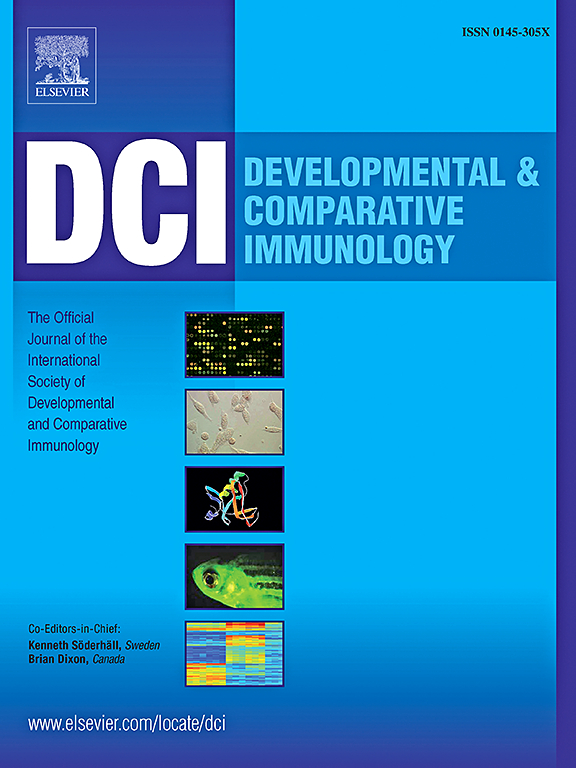斑马鱼利用保守的 CLR 和 TLR 信号通路来应对zymosan 中的真菌 PAMPs。
IF 2.7
3区 农林科学
Q1 FISHERIES
引用次数: 0
摘要
宿主利用模式识别受体(PRRs),如 C 型凝集素受体(CLRs)和 Toll 样受体(TLRs)来识别微生物中的病原体相关分子模式(PAMPs),并启动先天性免疫反应。虽然PRRs存在于无脊椎动物和脊椎动物中,但其中许多受体的功能同源性仍不清楚。在这项研究中,我们研究了斑马鱼幼体对zymosan(一种从真菌细胞壁中提取的含β-葡聚糖的微粒)的先天性免疫反应。巨噬细胞和中性粒细胞对玉米素做出了强有力的反应,并且是玉米素诱导的 NF-κB 转录因子激活所必需的。NF-κB对玉米素的完全激活取决于Card9/Syk和Myd88,它们分别是保守的CLR和TLR适配蛋白。两个推定的 CLR(Clec4c 和 Sclra)都是最大限度地感知玉米素和激活 NF-κB 所必需的,但不是炎症基因表达所必需的。总之,我们发现了斑马鱼幼虫体内促进真菌 PAMPs 识别的保守 PRR 和 PRR 信号通路。这些结果为在斑马鱼中建立人类真菌感染模型提供了信息,并增加了我们对脊椎动物中 PRR 途径的进化和保护的了解。本文章由计算机程序翻译,如有差异,请以英文原文为准。
Zebrafish use conserved CLR and TLR signaling pathways to respond to fungal PAMPs in zymosan
Pattern recognition receptors (PRRs) such as C-type lectin receptors (CLRs) and Toll-like receptors (TLRs) are used by hosts to recognize pathogen-associated molecular patterns (PAMPs) in microorganisms and to initiate innate immune responses. While PRRs exist across invertebrate and vertebrate species, the functional homology of many of these receptors is still unclear. In this study, we investigate the innate immune response of zebrafish larvae to zymosan, a β-glucan-containing particle derived from fungal cell walls. Macrophages and neutrophils robustly respond to zymosan and are required for zymosan-induced activation of the NF-κB transcription factor. Full activation of NF-κB in response to zymosan depends on Card9/Syk and Myd88, conserved CLR and TLR adaptor proteins, respectively. Two putative CLRs, Clec4c and Sclra, are both required for maximal sensing of zymosan and NF-κB activation but not required for inflammatory gene expression. Altogether, we identify conserved PRRs and PRR signaling pathways in larval zebrafish that promote recognition of fungal PAMPs. These results inform modeling of human fungal infections in zebrafish and increase our knowledge of the evolution and conservation of PRR pathways in vertebrates.
求助全文
通过发布文献求助,成功后即可免费获取论文全文。
去求助
来源期刊
CiteScore
6.20
自引率
6.90%
发文量
206
审稿时长
49 days
期刊介绍:
Developmental and Comparative Immunology (DCI) is an international journal that publishes articles describing original research in all areas of immunology, including comparative aspects of immunity and the evolution and development of the immune system. Manuscripts describing studies of immune systems in both vertebrates and invertebrates are welcome. All levels of immunological investigations are appropriate: organismal, cellular, biochemical and molecular genetics, extending to such fields as aging of the immune system, interaction between the immune and neuroendocrine system and intestinal immunity.

 求助内容:
求助内容: 应助结果提醒方式:
应助结果提醒方式:


